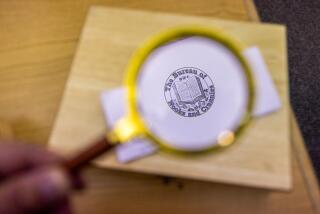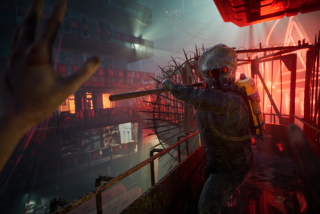The Player: A game made almost entirely of LED lights? It’s addictive, and it’s at IndieCade
IndieCade can be overwhelming. The Culver City game festival, which began Friday and runs through Sunday evening, boasts more than 200 titles. Dedicated to showcasing below-the-radar designers, IndieCade represents what’s next — and what’s adventurous — in gaming.
A core thread this year is intimacy. Games like “Cibele,” “Apartment: A Separated Place,” “Stellar Smooch” and “Consentacle” capture various points of romantic relationships, from the first kiss to the aftermath of a breakup.
There’s more. IndieCade isn’t limited to video games. There are board games, virtual reality games and even kid-friendly playground games. Some are borderline art installations. All take risks.
SIGN UP for the free Indie Focus movies newsletter >>
There’s a game called “&maybetheywontkillyou,” which is live action and explores the experience of being poor and black in America, and there’s a virtual reality game titled “Job Simulator,” in which robots of the future try to simulate the work experience. And speaking of robots, on Saturday night, players can sample “Maze of Heart,” a motion-sensor game in which a robot needs a soul.
You can’t see it all, but Hero Complex was on the IndieCade scene on Friday, and here are a few of the games that made an impression.
“Oxenfree.” A group of teenagers is camping on a mysterious island. Supernatural occurrences are channeled via a radio. There’s a rift in time and maybe some ghosts. All signs point to this being a horror game, but a short demo of “Oxenfree” felt more magical than scary. More importantly, it felt honest, as the dialog-heavy game is conversational rather than action-driven.
While a young teenage girl named Alex was exploring a cave she definitely should not have been inside, the player could direct her to be fearful or brave, humorous or anxious. Or maybe it was all a dream? The characters, after all, did eat some brownies with questionable ingredients. No, Alex was definitely talking to a triangle that materialized in the sky, but this mystery story sure felt dreamlike.
“We really always tried to hit this tone that’s as if you took ‘Freaks & Geeks’ and married it with ‘Poltergeist,’ ” said Adam Hines, co-founder of Night School Studios. “So you get the kind of real funny drama of kids in high school just dealing with their own issues, but then at the same time, you have these supernatural elements that will come into play and disrupt things. But we didn’t want it to be gory. We wanted a sense of wonder and play.”

“Line Wobbler.” Games like “Line Wobbler” are a primary reason to go to IndieCade. You may never get a chance to play it again. There’s a story to “Line Wobbler” (you’re apparently a character exploring a dungeon), but forget all of that because what will grab your eye is the fact that “Line Wobbler” is set entirely on a strip of LED lights.
And the controller? It’s made from a door stopper.
I didn’t get to play “Line Wobbler.” I didn’t want to interrupt the pack of kids who were clearly in awe of a game in which a green dot travels up a wall to take on red, purple and yellow dots. If it didn’t cost a few hundred dollars to make — and if the door stopper wasn’t so fragile — creator Robin Baumgarten may have the next great bar game on his hands. As it stands, the game is destined to be shown only at events, museum exhibits or festivals like Burning Man.
“People, especially kids, seem to be really gripped by this game. It’s really fascinating,” Baumgarten said.
Not bad for a game that’s basically red and green lights.
“It’s actually very tricky to convey an idea of what things are in an one-dimensional space,” Baumgarten said. “You have no graphics. That’s why the colors are what they are: Green is good; red is bad. It’s a very traditional color set. I have ideas to come up with more game mechanics, but that would make it harder to line. Like, what does blue mean? So I’ve kept it to very few components.”
“Fabulous Beasts.” Picture the popular stacking game “Jenga.” Now imagine “Jenga” with animals instead of blocks. Also, imagine that “Jenga” can interact with your iPod and that each block stacked brings to a life a digital environment that’s influencing your next move. Imagine said digital environment can be changed as the tower is built. Place the right combinations of pieces, for instance, and a bear can become a bear-fish.
Welcome to “Fabulous Beasts,” a video/table-top game hybrid that completely reinvents the game of balance. At first glance, this is a simple stacking game for children, but looks are deceiving. “Fabulous Beasts” comes with a weighted stand that ensures figures are placed properly and requires that each item — some in the shape of animals, some in the shape of natural elements — be scanned into the iPod before stacking.
It allows for essentially two games in one. There’s the core game of building a balanced tower, but each little totem is part of a greater ecosystem. If there are too many elements of one type, for instance, a bird may go extinct, and require the player shift course and potentially use figures that are not the best fit.
The result is a game that’s inviting to look at — tiny figurines in the shapes of sharks and plants are boldly colored and simple to handle — and has a surprising depth of strategy. It’s also tense. Occasionally, the iPad will launch a timer, requiring that a piece be balanced within a few seconds.
“There’s a lovely theater about a balancing game,” developer Alex Fleetwood said. “There’s this idea that you have to create a balanced world, physically and digitally. It’s fragile. Things can collapse without warning. There’s something about that that resonates with me right now.”
Right now, a festival like IndieCade is the only place to see it. “Fabulous Beasts” goes to crowdfunding site Kickstarter early next year.
“Nevermind.” “Nevermind” is a psychological horror game that’s ultimately designed to help players deal with stress. By wearing optional biofeedback technology — tools, for instance, that can measure your heart rate — the game universe will change. I struggled with one puzzle because I was simply too tense. I needed to relax for the game world to open up before me.
Out now for home computers and coming soon to the Xbox One, “Nevermind” follows a physician who is able to enter the minds of patients. In a demo, I wandered a creepy house. It was moody and a little frightening. The screen will sometimes flicker blood-red, and the ghosts — or memories, rather — of an abusive relationship haunt the surroundings. We hear of old fights, of neglect, and attempt to see how the sins of a parent forever scarred a child.
“We’re dealing with narratives around PTSD and psychological trauma,” creator Erin Reynolds said. “We really wanted to represent what it’s like inside the subconscious mind of people who are struggling with trauma and represent that in a way that’s artistically, abstractly accurate, if that makes sense.”
Rather than scares, the game emphasizes mental challenges. I wandered the house looking for memories, some in the form of broken puzzle pieces, others in the shape of fridge magnets. The biggest challenge was getting through at a relaxed pace, and Reynolds says that’s the point.
“When you play with the biofeedback sensor, which is completely optional, the game will become more difficult, more punishing as you start to experience feelings of stress or anxiety. Not only is it cool, but it’s to help players become more mindful of what sensations they feel when they get stressed. ... We reward the player for calming down by making the game easier.”
“Donut County.” Can a simple game with alligator people and one giant hole in the ground say big things about class struggles and gentrification? “Donut County” thinks so.
“Donut Country” is silly. The game essentially involves directing a hole to swallow the world around it. The goal is to clear the screen, to wipe out animals, homes, cars or whatever is needed. Influenced by playful games of physics such as “Katamari Damacy,” one travels around a cartoon-version of Los Angeles and swallows whole everything its sight. No, it’s not about how our city could suddenly fall into the ocean in the wake of a giant earthquake.
“Donut County” is about one family, and how the world around them becomes consumed and regurgitated in the name of progress. Designer Ben Esposito said the game was partly inspired by working in Culver City, and seeing mom-and-pop doughnut shops give way to fancier establishments. The shop in the game is based loosely on Randy’s Donuts.
“It’s for kids,” Esposito said, “but there is stuff for people who want to have some sort of subtext to it.”
As for the subtext?
“This is a game about gentrification in L.A. told through donuts,” Esposito said. “It takes place effectively at Randy’s Donuts, and you see this hole open up and you see the community change over time and people getting erased. That’s the super-high concept version.”
IndieCade
What: A festival dedicated to independent games
When: 9:30 a.m.-11 p.m. Saturday, 9:30 a.m.-6 p.m. Sunday
Where: 9300 Culver Blvd., Culver City
Price: Day passes, $30; Saturday night pass, $20
Info: www.indiecade.com
More to Read
The biggest entertainment stories
Get our big stories about Hollywood, film, television, music, arts, culture and more right in your inbox as soon as they publish.
You may occasionally receive promotional content from the Los Angeles Times.











